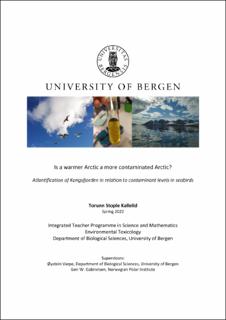Is a warmer Arctic a more contaminated Arctic? Atlantification of Kongsfjorden in relation to contaminant levels in seabirds
Master thesis
Permanent lenke
https://hdl.handle.net/11250/2985681Utgivelsesdato
2022-01-31Metadata
Vis full innførselSamlinger
- Master theses [270]
Sammendrag
The Arctic, and Svalbard in particular, is experiencing a more rapid warming compared to the global average. Such Atlantification of the Arctic may change food webs in a way that can also affect the contaminant levels in top predators such as seabirds. Studies have found that the black-legged kittiwake (Rissa tridactyla) in Kongsfjorden, Svalbard, has changed its diet from mainly Arctic prey items towards a more mixed diet with contribution from Atlantic species since 2007. Atlantic species might function as biovectors, bringing contaminants into the Arctic from more contaminated areas. However, Arctic species might have a higher contaminant load, due their high lipid content. My thesis explored if changes observed in dietary ecology, using two different approaches, can explain variability in black-legged kittiwake exposure to organochlorine contaminants during the years 2007-2020, here represented by seven compounds including polychlorinated biphenyl (PCB) 99, PCB 153, PCB 180, β-hexachlorocyclohexane, hexachlorobenzene, p,p’- dichlorodiphenyldichloroethylene (DDE), and oxychlordane. Dietary ecology was quantified by both frequency of occurrence of diet items and groups from regurgitate samples and by stable isotope analysis. Stable nitrogen isotope values (δ 15N) have been established as a proxy for trophic position, and stable carbon isotope values (δ 13C) indicate foraging habitat and primary carbon source. Annual variation in frequency of occurrence of prey species (or groups) did not explain the variation in either δ 13C or δ 15N values. There were significant differences in the annual variations in contaminants levels, but there was no clear temporal trend for any contaminants during the study period. Model selection showed that neither diet items nor stable isotope values explained the variation in contaminant levels. Instead, the null-model, with year as a random effect factor, was often ranked as a strong model. However, some variables, such as trophic level, carbon source and frequency of occurrence of herring, as a representative for Atlantic species, seem to have a possible relationship to contaminant exposure. Neither the claim that Atlantic species function as biovectors, nor that Arctic species have high contaminant load due to high lipid content, is supported by this thesis, as there was no clear relationship between variation in contaminant levels and the degree of Arctic or Atlantic prey species. The Atlantification and the current climate warming might affect contaminant levels in blacklegged kittiwake in Kongsfjorden in other ways not studied in this thesis, such as through reduced body condition or though changes in the physical environment.
